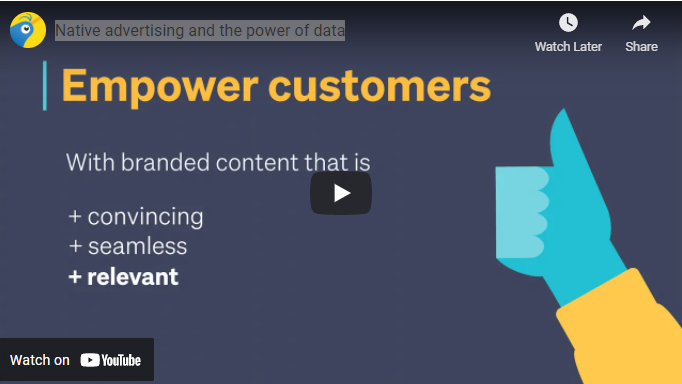News Next article
Native Advertising and the Power of Data
There is a vast range of native products available and definitions of exactly what “native” advertising is
21 May 2019The industry has seen a 270% increase in native advertising spend in the past two years in New Zealand. As marketers have tapped into the potential of native advertising, they’ve driven its exponential growth¹. This trend isn’t likely to slow any time soon, so harnessing the power of data is becoming fundamental to your success.
What is a Native Ad?
Whether it’s in the form of sponsored content or placed in-between search results (like a Trade Me listing), there is a vast range of native products available and definitions of exactly what “native” advertising is. To us, “native” describes our ad product that is designed to fit seamlessly into the user journey — the ad matches the site layout, fonts and graphics. This placement typically drives higher engagement as it is in the same environment as the content your audience is actively seeking.
Last year, native ads performed 39% better in driving direct response². This is evidence of the shift in how consumers attention is being captured. Hence, the recipe for success in 2019 calls for content that is more relevant, convincing, seamless and coupled with smart data segmentation.
Data persona targeting
On an average day, we see over 8.5 million³ member interactions across our data management platform — this is the sum of all the searches, views and watchlists that happen on Trade Me in 24 hours. We have segmented this data into useable audience groups that we call data personas. Data personas are specific audiences that are qualified by their demographics and onsite behaviours. From “first home buyers” to “Dairy Farmers” to “Apartment buyers”, we have over 100 data personas available to target.
Why mobile-first strategies win:
Our numbers show that mobile-first research is still trending strongly. In other words, the number of searches on mobile is still increasing year on year as more users begin their purchasing journeys on a mobile device. So, optimising your native ads for the shorter session times on mobile with attention-grabbing and concise creative should be at the forefront of your strategy. Great native advertising stops the user in their tracks with valuable information or offers that are hyper-relevant to the content that surrounds the ad.
What makes a great Native ad?
To achieve the perfect balance of capturing a users attention, building relevance and driving action, there are four key elements to consider. These are the headline, imagery, call to action and smart targeting. These components work together to achieve the perfect balance.
If we look into imagery first, in just 13 milliseconds⁴, images fill us with emotion and using familiar brand assets can help trigger memories and strengthen ties with your brand. You can set the stage for your headline with a compelling image that draws the user in.
Next, the headline is the window to your value, it tells a story about your product or brand and paints a picture for the user. The call to action is consistent with what you want your audience to do. If they are clicking to download something, sign up or find out more information about your product, then tell them that’s what they’ll be doing.
A great call to action is succinct and sets clear expectations for people that are thinking about clicking on your ad. Make sure it is action-based and straightforward, like “Download the free app”, “book your appointment now” or “see how much you can save”.
Finally, use smart targeting to ensure your ad is going to get in front of the right audience at the right time and meet your campaign objectives.
You can check out our personas here and get some ideas rolling or have a chat with one of our account managers by sending us an email.
¹ IAB revenue report Q1 2017 - Q4 2018
² Trade Me Doubleclick for Publishers FY 201
³Salesforce Audience Studio, April 2019
⁴Potter, M. C., Wyble, B., Hagmann, C. E., & McCourt, E. S. (2014). Detecting meaning in RSVP at 13 ms per picture. Attention, Perception & Psychophysics,76(2), 270-279
Native advertising and the power of data
Video - Empower Customers

